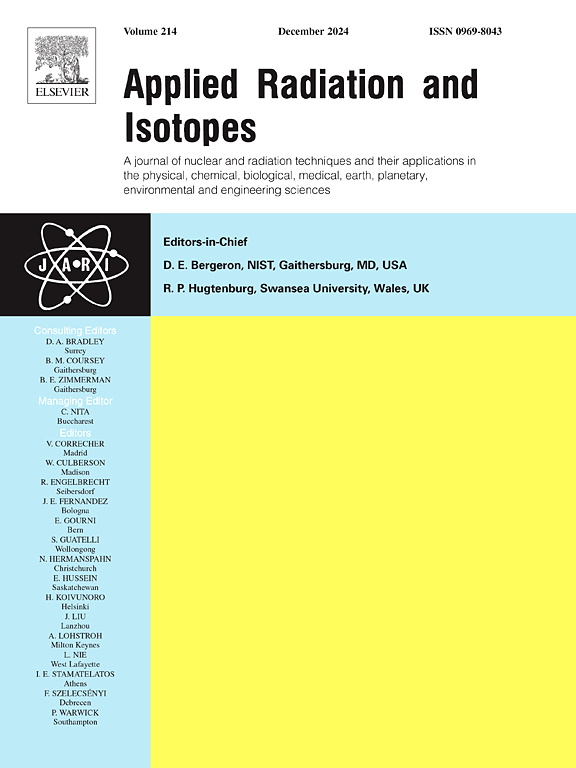Quadratic parametrization of the maximum alpha track lengths in CR-39 detector for various energies and incident angles
IF 1.6
3区 工程技术
Q3 CHEMISTRY, INORGANIC & NUCLEAR
引用次数: 0
Abstract
CR-39 is a widely used solid-state nuclear track detector for alpha-particle detection. In this study, the alpha-particle range was investigated for various incident energies and angles using Geant4 Monte Carlo simulations. The maximum track length was measured and found to exhibit a quadratic dependence on the primary energy of the incident alpha particles. Additionally, the distribution of maximum longitudinal length as a function of particle energy revealed that the critical detection angle for alpha particles in CR-39 is 71° for a chemical etching solution of 6.25 N NaOH at 70 °C. For a minimum etching time of 40 min, required for track visualization under an optical microscope, the energy threshold ranges from 0.191 ± 0.001 MeV for normally incident particles to 10.87 ± 0.02 MeV for a dip angle of 71°. In the context of radiation level monitoring using CR-39, the optimal chemical etching time for reliable track density measurement is 400 min. Under this condition, the energy threshold varies between 3.13 ± 0.01 MeV for normal incidence and 14.3 ± 0.2 MeV at 70°. Notably, for incident angles of 71° or greater, no detectable tracks are observed at this etching time.
CR-39探测器在不同能量和入射角下最大径迹长度的二次参数化
CR-39是一种广泛应用于α粒子探测的固体核径迹探测器。在本研究中,使用Geant4蒙特卡罗模拟研究了不同入射能量和角度下的α粒子范围。测量了最大轨迹长度,发现与入射α粒子的初级能量呈二次依赖关系。此外,最大纵向长度随粒子能量的分布表明,在70±0.1°C的6.25 N NaOH化学蚀刻溶液中,CR-39中α粒子的临界探测角为71°。在光学显微镜下,轨迹可视化所需的最小刻蚀时间为40分钟,正常入射粒子的能量阈值为0.191±0.001 MeV,倾角为71°时的能量阈值为10.87±0.02 MeV。在CR-39辐射水平监测的背景下,可靠磁道密度测量的最佳化学蚀刻时间为400 min。在此条件下,能量阈值在正常入射时为3.13±0.01 MeV,在70°时为14.3±0.2 MeV。值得注意的是,入射角为71°或更大时,在此刻蚀时间内没有观察到可检测的轨迹。
本文章由计算机程序翻译,如有差异,请以英文原文为准。
求助全文
约1分钟内获得全文
求助全文
来源期刊

Applied Radiation and Isotopes
工程技术-核科学技术
CiteScore
3.00
自引率
12.50%
发文量
406
审稿时长
13.5 months
期刊介绍:
Applied Radiation and Isotopes provides a high quality medium for the publication of substantial, original and scientific and technological papers on the development and peaceful application of nuclear, radiation and radionuclide techniques in chemistry, physics, biochemistry, biology, medicine, security, engineering and in the earth, planetary and environmental sciences, all including dosimetry. Nuclear techniques are defined in the broadest sense and both experimental and theoretical papers are welcome. They include the development and use of α- and β-particles, X-rays and γ-rays, neutrons and other nuclear particles and radiations from all sources, including radionuclides, synchrotron sources, cyclotrons and reactors and from the natural environment.
The journal aims to publish papers with significance to an international audience, containing substantial novelty and scientific impact. The Editors reserve the rights to reject, with or without external review, papers that do not meet these criteria.
Papers dealing with radiation processing, i.e., where radiation is used to bring about a biological, chemical or physical change in a material, should be directed to our sister journal Radiation Physics and Chemistry.
 求助内容:
求助内容: 应助结果提醒方式:
应助结果提醒方式:


